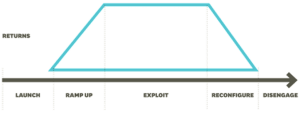It’s been a long standing belief that a company must have a sustainable competitive advantage to excel. But, lately, there has been an upsurge of popularity for a different but related concept, ‘transient competitive advantage’.
Transient competitive advantage refers to the practice of taking up new strategic initiatives based on short term or transient advantages. This is novel because the norm has always been to build a business around something that is lasting and will provide an enduring competitive advantage.
A sustainable competitive advantage is the practice of finding a profitable opportunity that can deliver an advantage that competition cannot match for many years. This advantage can take the form of differentiation, new business model, entry barriers, ownership of critical resources, etc. anything that blocks competition for a long time. For example, SouthWest Airlines’ business model of flying short hauls between small city airports gave it an advantage that competition could not match for years. Dell’s strategy of mass-customization gave it an advantage that lasted many years.
Changing times have propelled a move towards the concept of transient competitive advantage. At a time when scenarios shift dramatically in a short period of time, executives are recognizing the merit of looking at the short term rather than the long term.
The digital revolution and globalization are the two main factors that have increased the pace of change and shortened the durability of most concepts. Companies can innovate or imitate faster now than ever before. With faster information flow and quicker research – nothing remains a secret for long and no product remains unique for long. Entry barriers have become meaningless in many industries due to outsourcing. Businesses have a shorter window for success and so it makes sense for them to run with opportunities that deliver a short term competitive advantage.
With volatile business environments, companies continue with strategies from stable times. A business plan put together during good times can comfortably draw from resources. Continuing with such a plan in difficult times can leave you with depleting resources and increasing costs. And soon, the advantage will run out of steam and your company will be left in the lurch.
An example of this scenario is Kodak, from the photography industry. In 1973, the Hunt brothers, oil and gas billionaires, decided to increase their stock of silver and prices of this commodity shot through the roof. Kodak was one of the major consumers of silver and tried to break away from this stranglehold by inventing the digital camera. This was a great example of a transient competitive strategy. However, what they didn’t do was capitalize on this advantage. They remained dependent on a film-based model for far too long.
Companies should consider transient competitive advantages to survive in today’s competition intensive and barrier-free environment. They need to look at developing transitory business strategies that consider the crucial market and company variables from that time. These strategies should evolve as soon as there is a change in the important variables.
A culture of constant innovation lies at the heart of transient competitive strategy. Innovations earn profits only if they take current market conditions into consideration. The importance of innovation was stressed by GE CMO Beth Comstock during the recently concluded Marketo summit.
The lifecycle of any transient competitive advantage typically looks like this:

A transient competitive advantage kicks off with a launch procedure during which the company identifies an opportunity and organizes resources required to utilize the opportunity. In this first phase, you need employees who are willing to embrace new ideas and structures. It takes an open mind to understand changing contingencies and create strategies accordingly.
In the second phase, ramp up, the idea is scaled up. This stage requires employees who have good organizational and planning skills. The required resources with the right quality levels have to be collated at the right time for the idea to materialize into reality.
The third phase of exploit is where it can be possible for you to gain profits and market share and compel competitors to answer. You need employees who are good at mergers and acquisitions, analytical decision making and are efficient.
If your competitors do answer your product move in kind, it so happens that the competition you spawned dilutes your advantage. So, you will need to re-configure your advantage to maintain the uniqueness. This stage needs employees who aren’t afraid to juggle the box a little and revisit strategies or resources.
More and more companies are realizing the necessity of transient competitive advantage. Here are a few companies who have adopted the concept:
The photography business provides us with another example:
There was another company from the photography industry at the time of the Kodak episode. Fuji, the other player, was also affected by the control of silver of the Hunt brothers. However, what set Fuji apart from Kodak was that it recognized that depending on chemicals whose cost they couldn’t control would always make their business vulnerable. Fuji started investigating opportunities for photography to be less dependent on chemistry.
Today, Fuji is a leading company in the photography industry with revenue of about $560 billion for fiscal year 2014.
What are your thoughts on transient competitive advantage? Do tell us in the comments below.
Image source: Strategy capstone